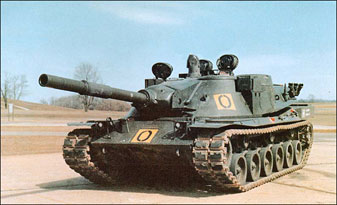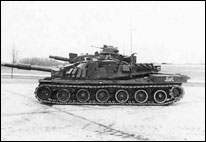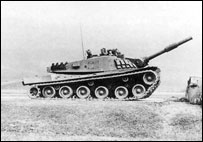
MBT 70: Development of a new concept: The MBT-70 was a 1960s joint U.S.-German project to develop a new main battle tank using a number of advanced design features. By the late 1960s the project was well over budget and the Germans withdrew from the effort, developing their Leopard 2 instead. Development continued in the US, but the per-unit cost had risen five times, and in 1971 Congress overrode the Army's objections and the MBT-70's funding was redirected to create the M1 Abrams. Leading up to the MBT-70 project it became clear that the USSR was planning to introduce an updated version of their T-62 design using an auto-loading gun and better armor (eventually delivered as the T-64). The new design would place the US's existing M60 tanks at a disadvantage, so they started looking at designs that would leapfrog any potential Soviet design. The same was true for the Germans, whose recently introduced Leopard 1 tanks were now looking like they would be outgunned only a few years after being introduced. An upgrade project for the Leopard was already underway, but it appeared this model would not be enough of an advance on the state of the art to be worthwhile.
The result was a joint agreement to develop a single new tank for both armies. However this may have been one of the worst things to happen to the project, as both teams started "pulling" the design in their own directions. Practically every part of the design was argued over, the gun, the engine, even whether or not the design would use metric or SAE measurements. The latter debate was eventually "settled" by deciding to use both, thereby increasing costs considerably. MBT 70 Features: Many of the features of the MBT-70 were ahead of their time. It used an advanced hydropneumatic suspension system that allowed for fast cross-country speeds even though it was to weigh 50 tons. The suspension could be raised or lowered on command by the driver, down to put the bottom of the tank just over 100 mm (4 inches) from the ground, or up to 28 inches (700 mm) for cross-country running.
The armor consisted of two spaced layers, the inner a softer steel that also served as a spall liner, and the outer of harder cold-rolled steel. The spacing was included to help defeat HEAT rounds, notably those on wire guided missiles, then the bane of the tank. The design included bulkheads, fireproof doors and blow-out sections in the ammunition storage area to minimize crew injury when a hit was received. The MBT-70 was designed with a low silhouette, something which had not been addressed on the M60 whose high silhouette was considered a serious drawback. In fact the MBT-70 ended up so low, just over 6 feet (1.8 m) from the floor to the top of the turret, that there was no room for the driver in the main hull. Instead he was placed with the rest of the crew in the seemingly oversized turret, in a contra rotating cupola that was geared to keep him facing forward. If needed, the cupola could be turned around to face to the rear, allowing the tank to be driven "backwards" at full speed. A low silhouette was a very distinct feature of the roughly contemporary turretless Swedish Stridsvagn 103, or S-Tank. MBT 70 Layout: US versions were to mount the new Continental AVCR air-cooled V-12 diesel of 1470 hp (1096 kW). German versions originally used a similar Daimler-Benz model, but later moved to an MTU design of 1500 hp (1,100 kW). The MTU unit could be easily swapped out of the tank, along with the drive train, in 15 minutes. Both versions could reach 43 mph (69 km/h) on their engines, at the time an unheard-of speed for such a large tank. The US version was armed with the new XM-150 auto-loading stabilized 152 mm gun/launcher system equipped with a laser rangefinder, then a new-fangled device. The gun was a medium-velocity design that fired artillery-sized shells in the anti-personnel and short-range anti-tank role using HEAT rounds. For long-range firing the gun switched to the Shillelagh missile instead. The result was a light gun with the same firepower as a much larger "standard" design. The Germans were always suspect of this design and instead planned to equip their versions with their newly-developed Rheinmetall 120 mm gun, also equipped with an auto-loader. Secondary armament for both consisted of a remote-controlled 20 mm cannon that popped up from a hatch behind the driver's cupola for anti-aircraft use, a 7.62 mm machine gun mounted alongside the main gun, and smoke dischargers on either side of the rear turret. The use of an auto-loader for both versions allowed the crew to be reduced to three, commander, gunner and driver.
A prototype series started in 1965, with one mild steel hull and six "complete" hulls of both the US and German versions, for a total of 14 hulls. The lower hull and drivetrain were tested in 1966, and full trials began in 1968. A problem that was not anticipated was that the drivers complained of disorientation when the turret was rotated, contrary to the predictions of the designers who felt the location of the cupola near the center of rotation would eliminate this effect. The German 120 mm proved excellent, but the XM-150 was a serious problem. The similar but smaller XM-81 mounted on the M551 Sheridan was proving just as finicky. On the upside, the tank proved to be better than the M60 in all other ways. It was considerably faster, both in all-out speed and, more importantly, with about three times the acceleration. In cross-country performance the high power engine and excellent suspension allowed it to travel almost three times as fast as the M60 without causing problems for the crew. All of this led to a reduction in the time the tank was exposed to fire, in testing it was 1/3rd less likely to be seen while maneuvering than the M60, and it could run a 10 km (6 mile) obstacle course in 30 % less time. 
By 1969 the MBT-70 cost five times what was projected, at $1 million a unit. Germany backed out of the project, and re-started development of what would become the Leopard 2. At this point Congress also started to make noises about the price, which the Army responded to by introducing a lower-cost system based on the same design, known as the XM803. This succeeded only in producing an expensive system with capabilities similar to the M60 it was supposed to replace. Congress, angered by the delays and cost overruns, cancelled the project in November 1971, and redistrubuted the funds to the new XM815. This project was later renamed XM1, the project that led to the M1. The ARMOR Site! is © Copyright 1997-2006 Fabio Prado . All Rights Reserved. |
||||||||||||||||||










